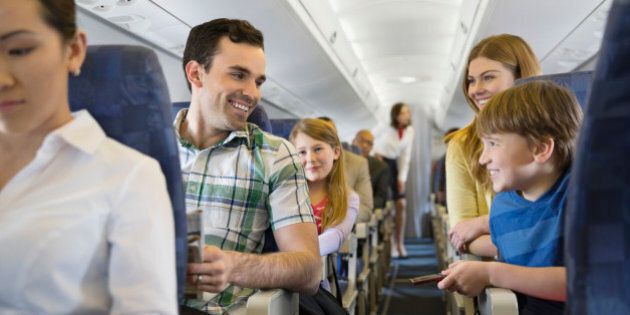
"Keep going, kids." Says the weary adult as their child optimistically looks at the business class seats on their way to the way, way back of the plane. As they pass the front section, past the premium or preferred economy seats, the spacious exit row seats, and find themselves in the last row, middle seats, not even together they wonder "why does this always happen to me?"
Experienced air travellers know all the tricks and tips to secure the best seats on the plane. Now, I'm not talking about paying thousands of extra dollars for business or first class seats -- anyone with a bit of money can do that -- but more how to score the best in the economy section, at little or no extra cost.
The "best" seat of course is a personal choice; some prefer the aisle, others the window (I've yet to meet a person who prefers the middle seat), most like the front of the plane over the back, but not all. My personal preference is aisle, close to the front, but not the bulkhead because you can't store a bag under the seat in front of you.
Exit rows are an appeal for some, while it makes others nervous. It is important to note that exit row seating will not be given to children, those who require a seat belt extension, or those with physical disabilities that would not allow them to perform the required functions in case of an emergency. An extra benefit to exit row seating (besides extra legroom) is you normally board before the rest of the plane, giving you plenty of time and opportunity to score coveted overhead bin space.
But how can you figure out what the seat configuration of your plane is, before you've booked your flight? You can check out sides such as Seatguru.com; once you've booked your flight, you will be given the opportunity to review the seat options of your particular plane. Many planes are three across either side of the aisle, but smaller flights can see one seat on one side, and two on the other, while larger flights can see a middle section of seating as well.
Many airlines offer premium economy which, for a fee of anywhere from $15 - $50 typically, you can reserve and pre-book the first few rows in economy, as well as the exit row seating. Others, like Air Transat, offer "plus" seating which gives you food and beverages as well, but these costs can run into the hundreds of dollars.
If you're a frequent flier and have accumulated miles or credits, check to see if you can redeem these for an upgrade.
Otherwise, you'll have to wait until 24 hours before your flight departure time to check in online, and select a regular economy seat. And don't kid yourself; many people (perhaps myself included) set timers to go on to the airlines' site at exactly 24 hours before their flight time. Waiting even five minutes can cost you that seat.
Many experienced fliers who are travelling with a companion will book the window and the aisle seat, leaving the middle seat open. This is less likely to be booked by another passenger, than if they had left either window or aisle open. Should the middle seat become booked, there's a 99.9 per cent chance that person will switch with either of your seats, still allowing you to sit together.
If you are trying to book seats together, but others have beaten you to it, you can always consider registering with Expertflyer.com. For $0.99 per request, you can ask for email alerts should a particular seat, or general type of seat become available on your flight. It covers most airlines -- Air Canada and WestJet included.
If your travel dates are flexible, try to travel mid-week to avoid the weekend, or Monday morning and Friday afternoon rush. The Toronto/Montreal/Ottawa and Vancouver/Calgary/Edmonton corridors are a nightmare beginning and end of week, and even beginning and end of day. Book midday if you can on these busy business travel routes. Also, be aware that many business travellers are savvy to seat selection strategies and likely have "status" with the airlines' frequent flier programs, so your options will be limited right away.
But what if all of your efforts are in vain, and you're still not in an optimal seat or separated from your travel companions? Flight attendants are most likely not going to help you solve your dilemma, although you can let them know that you are interested in switching. Most airlines will suggest you have to wait until the flight is in the air, or at least until the cabin doors are closed. You cannot switch to an upgraded seat unless the airline allows you to pay for it on the spot.
Don't assume others will automatically switch seats with you; they may have specifically chosen that seat for comfort, personal or superstitious reasons (many people don't want row 13, for example). Ask politely and if they turn you down, look for other options.
And one more thing; if you should end up getting the middle seat, common airline etiquette dictates that you "own" both arm rests. Fellow passengers may not subscribe to this, but if you are in a window or aisle seat, keep this in mind for your struggling middling companion.
Kathy Buckworth's "How She Travels" segment can be heard on "What She Said" on Sirius/XM Canada Talks, Channel 167. Check out her travel blog here.
Follow HuffPost Canada Blogs on Facebook
ALSO ON HUFFPOST:
